Elements of the Spitz's nature
Why the German Spitz is the way he is
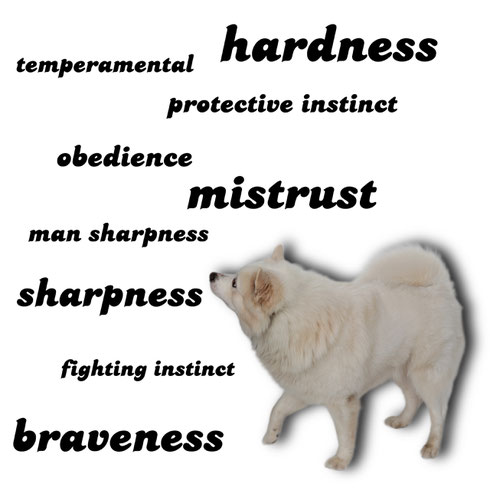
If you find out about the German Spitz online or in books and specialist magazines, you will quickly come across terms such as “sharp”, “man-sharp” or “suspicious”. However, one often only has a rough idea of their significance.
Unfortunately, descriptions such as those in the picture opposite, which define the nature of the German Spitz, are often only handled very carefully - or even avoided entirely. Alternatively, euphemisms are also often used to phonetically “pretty up” elements that sound undesirable. Since not everything that doesn't initially sound "positive" or "friendly" is necessarily bad, I would like to break down the terms that describe the Spitz's nature in a comprehensible way.
The articles in the category "Spitz heroes" show how useful it can be to put more emphasis on the importance of the German Spitz as an energetic and relatively undemanding guard and working dog (with all its martial-sounding attributes) - instead of breeding the Spitz into a useless toy dog. All the stories listed there actually happened and are very nice examples of how important the "martial" sounding elements are for the Spitz's nature that we now want to discuss.
I would also like to address whether a dog with such characteristics is actually a contemporary family dog - or just a dusty relic of days gone by?
Furthermore, it is important to me to go through the elements of the Spitz's personality here, because I am of the opinion that if you want to live and work properly with another living being, it is absolutely necessary to understand its basic drives and characteristics. However, it is by no means my intention to give a detailed account of the psychological structure of the breed. But that would go way beyond the scope of this article.
1.) The elements of the Spitz's nature and their meaning
One of the core descriptions of the German Spitz comes from the FCI breed standard:
Excerpt from FCI Standard No. 97/12.11.2019/D - German Spitz:
"The German Spitz is always attentive, lively and extraordinarily attached to its owner. It is very teachable and easy to train. Its natural distrust of strangers and lack of hunting instinct make it the ideal companion and family dog and watch dog for home and farm. It is neither timid nor aggressive. Indifference to weather, robustness and longevity are its most outstanding attributes."
A 1960 standard explains:
"A purebred German Spitz, whether large or small, should never allow strangers to touch it, but should always be suspicious and distrustful." [2]
Especially in the FCI standard, the characteristics are sometimes a bit “cryptic”. In order to understand this better, let's first look at the elements themselves - because they are, so to speak, the wheels on which the "German Spitz" machine runs:
braveness
fighting instinct
temperament
obedience
protective instinct
sharpness
hardness
man sharpness
mistrust
Everyone actually knows what braveness is, but if you want to explain the term, you could spend entire volumes on it. It is important that there are dogs that run away in dangerous situations and others that stand their ground and support their humans in such situations.
The term temperament refers to the basic mood of the individual. On the one hand, this affects the emotional tone and, on the other hand, the living being's willingness to react. Emotional tone is understood as the tendency to a certain affective state, e.g. the tendency to remain in feelings of pleasure or the opposite tendency. These include type terms such as choleric, melancholic and sanguine, while the term "phlegmatic" actually refers to the second factor of the temperament concept, namely the ability to react. Phlegmatic is a dog that is not very reactive, and the fluctuations between pleasure and displeasure are so small that they can easily be overlooked. This willingness to react is now what is understood by temperament in the narrower sense, i.e. the dog's basic willingness to react strongly or hardly to environmental stimuli. In contrast to the term "sharpness", however, this refers to all stimuli - good and bad - that are responded to by the dog in question with either happy or negative emotions. Those dogs who easily respond to environmental phenomena with all kinds of emotional excitement are called temperamental, while their opposite is called temperamentless.
Protective instinct is the dog's willingness to assist humans in the event of attacks. Due to the protective instinct, the dog responds to attacks on its human companion with hostility. If the dog is also brave, this hostile behavior can lead to fighting.
Hardness is the resistance that a being is able to offer to unpleasant impressions. This is best made clear with an example: A dog that was once hit by a car and then becomes afraid at the sight of a car for a long time - or even for the rest of its life - is called soft. Another dog who quickly forgets this experience and shows no fear of cars despite the unpleasant experience is a tough, a hard dog.
The term mistrust refers to a dog's general suspicion of everything strange or unknown, a quality that is essential for a reliable guard dog. A German Spitz - whether big or small - should never allow strangers to pet him, especially not in the absence of his master.
Fighting instinct is the joy of fighting itself, the same thing that the young hot spur's rowdiness is.
Obedience is the dog's tendency to allow itself to be led by humans, that is, to respond willingly and without resistance to their training influences and educational measures.
Sharpness is the dog's willingness to react hostilely to stimuli that approach it from outside. The dog that responds to any noise, to the appearance of a stranger or to any other unusual impression with a "hostile" mood (growling, showing teeth, raising hair) is therefore a sharp dog, while another who does not show such signs is can be described as not sharp. The predator sharpness also arises from the sharpness itself.
Man sharpness is the dog's willingness to engage in combat, especially with humans - or the dog's ability to actively counter any apparent or actual threat from humans. [3]
2.) Translation to the “German Spitz” standard
Here's the FCI standard again...
"The German Spitz is always attentive, lively and extraordinarily attached to its owner. It is very teachable and easy to train. Its natural distrust of strangers and lack of hunting instinct make it the ideal companion and family dog and watch dog for home and farm. It is neither timid nor aggressive. Indifference to weather, robustness and longevity are its most outstanding attributes."
…and its translation:
attentive = vigilant
easy to train = obedient
lively = temperamental
distrust = mistrust
non-timid = brave
teachable = clever
attached = related to the master
non-aggressive = no over-sharpness
And as a text as a whole:
"The German Spitz is always vigilant, temperamental and exclusively focused on his master and his property (protective instinct). He is clever and obedient. His natural mistrust of strangers and his lack of hunting drive predestine him to be the ideal companion and family dog, and a guardian for the house and yard. He is brave and has appropriate sharpness (not over-sharpness). Weather insensitivity, robustness and longevity are his most outstanding characteristics."
As you can clearly see at this point, the characteristics of the German Spitz discussed are not some irrelevant nonsense that people like me still sigh for. No, these characteristics but are still described in the current breed standard.
My only objection to the standard relates to its ease of use. In principle, the old type German Spitz is quite easy to handle - if you know how. However, his temperament and intelligence are diametrically opposed to the classic easy-going known from other breeds of dog.
3.) The German Spitz as a guard dog
There is probably no other animal species that exhibits such a variety of forms and behavior as the dog. The ways in which it is used are just as varied as the dog's appearance. Of course, we Spitz-people are particularly interested in the dog's use as a guard and farm dog. On the one hand, we require him to report any strangers approaching his master's belongings and - if necessary - to stop or drive them away. On the other hand, we demand that in the event of a personal attack on one of his family, the dog actually protects this person - and cannot be distracted with a stick, chased away by throwing a stone or by being bribed with a treat. This is exactly why our German Spitz needs the temperament building blocks discussed above. Without them, he wouldn't be a proper guard dog who shouldn't be afraid to step forward and use his teeth in an extreme emergency! Such a dog also has to be particularly good at obedience in order to be able to let go immediately when commanded or whistled - especially in a fight!
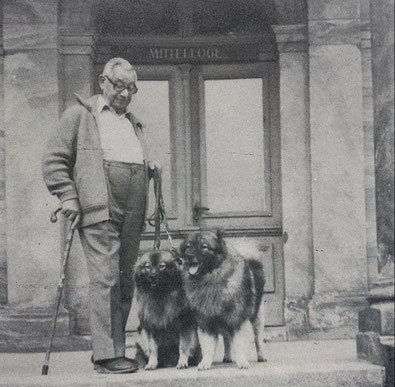
In the case of dogs with weak temperaments, however, the fighting mood can degenerate into blind rage; this is then called over-sharpness. Since it can hardly be controlled educationally, it is just as undesirable as pseudo-sharpness, which occurs, for example, in fear-biters and has nothing to do with real sharpness which comes out of courage of heart.
A good guard dog must therefore be equipped with a certain (controllable!) level of sharpness. The sharpness itself is related to the instinct of self-preservation, and if this instinct is very strong, it can easily lead to a certain "fearfulness" in the dog. However, a pinch of anxiety is definitely useful for a guard dog because it keeps attention at a high level and thus promotes vigilance. Under no circumstances should the anxiety increase to such an extent that the dog becomes extremely vigilant and reports every, really every, insignificant little thing with never-ending barking.
Most dogs are suitable as a simple “alarm system”, but very few have any “combat value”. Here you have to resort to a proper guard dog like the Spitz, who is a born guardian. We expect him to step forward when there is danger and to take action in an emergency. And that requires mistrust, courage and sharpness.
How much the German Spitz has always distinguished itself as an unsurpassable guardian of house and yard, and that this also requires characteristics that don't initially sound cuddly and sweet, is clearly shown by this old text:
"The Spitz's hearing is unsurpassably good and the slightest impropriety on his terrain is signaled by him with frenzied barking, which he continues for hours with increasing anger until his voice breaks, and he becomes completely hoarse. Only after the object of his displeasure has disappeared, he calms down again. He guards what is under his care with such conscientiousness and guards and protects it with such angry jealousy that he is ready to risk his life for the smallest thing, but not to want only abandon it. He does not leave his territory, which he regards as his property, as his castle, as long as he carries out his guard duty. If he goes outside his district, strolls around and sees something suspicious, he rushes straight home and awaits the enemy at the border of his property. The Spitz is satisfied if the enemy runs away; he considers pursuing beyond the border to be beneath his dignity. He is kind to his master and a flatterer. His eyes shine, and he twists and turns, crawls and jumps with delight when the master's hand pets him, when flattering words are spoken to him. [...]...if you need a loyal guardian, he is absolutely irreplaceable. " [4]
Phrases such as “with increasing anger”, “angry jealousy” and “enemy” indirectly describe the sharpness of the German Spitz, which is indispensable for his guard duty. This typical sharpness definitely includes aggressive aspects, or as an old book about hunting says:
"The sharpness in dogs should primarily consist of a pronounced hatred of all predators. This hatred forms the driving force behind the persistent pursuit of a robber. [...] The development of this sharpness has an astonishing influence on the temperament of the dog: an extremely sharp dog is also an extremely temperamental dog. The young dog, which promises to become a sharp dog later on, shows this disposition even in its youth. He is bright, agile, cheeky and suspicious of strangers, and sometimes behaves completely rabidly against stray cats, crows etc. and barks at them or chases them. Even mice, rats and corvids are not safe from him even in his early youth." [5]
Sharpness and predatory drive therefore have absolutely nothing to do with the hunting drive itself - because a hunting dog certainly does not pursue a fawn out of hatred, but in order to ultimately kill and eat it. Sharpness has its roots in the territorial instinct. It is used as a negative trait but needs a huge courage of heart.
4.) The German Spitz as a protection dog
The basic difference between a guard dog and a protection dog is that the guard dog works from home, while the protection dog is supposed to be vigilant wherever he is with his master.
Now there are dogs that are very alert and reliable in their own territory, but need a long time outside until they get used to it so that they can also reliably watch in their new territory. Such a dog is certainly not particularly suitable as a protection dog. A proper protection dog must, in a sense, view its master as the center of a wandering "home" and guard wherever he is with him.
The character building blocks required for protection work are identical to those of the guard dog; here too, the animal's braveness and sharpness play a major role. For example, a dog that moves backwards in front of a raised stick is no more a good protection dog than one that is brave but completely without sharpness.
5.) Braveness and sharpness
The difference between braveness and sharpness must be clearly emphasized at this point, because there is a contradiction between the two terms. Courage or braveness is a phenomenon of domestication, a consequence of thousands of years of living with humans and under their protection, while sharpness, on the other hand, is a consequence of the instinct of self-preservation, it is the hostile, highly reactive distrust of everything unknown, paired with aggression. However, the two essential elements can mix with each other and result in the following four combinations:
Brave and at the same time sharp dogs
Brave but sharpless dogs
Faint-hearted and not sharp dogs
Faint-hearted, sharp dogs

These are the four types, which in turn contain a multitude of intermediate stages and nuances. The sharp dog immediately assumes a hostile attitude towards the unknown and/or unusual, as well as towards a threat. He growls, barks, bares his teeth and his hairs stand on end. If he is brave at the same time, then he will go forward and try to fight. If, on the other hand, he is faint-hearted, he will try to escape - i.e. back away or pull backwards on a taut leash. The non-sharp dog will show no signs of hostility towards the same events. So he won't growl, bark or attempt to attack. If he is brave, he will stand still, look and listen attentively to see what is strange, perhaps even curiously approach without any signs of aggression. If, on the other hand, he is faint-hearted, he will want to get to safety without any signs of hostility. [3]
6.) Is a sharp dog like the German Spitz actually a good family dog?
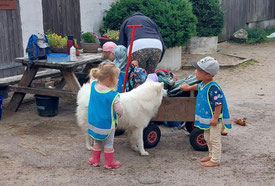
Yes, yes and yes again! Even if the description of the German Spitz sounds like you need a gun license at first, you shouldn't be blinded by it. Because a family dog is a dog that is particularly attached to its family. A dog that guards and protects its family - and doesn't let himself be petted by any strange, shady character or allow to be bribed with a piece of meat. Therefore, a proper family dog MUST be sharp, suspicious, brave, highly reactive, ready to fight and alert if he shall effectively protect his family, otherwise he is nothing more than a yapping alarm system. The grim dog, who is not afraid to effectively fend off people if necessary to protect his family, is therefore a particularly perfect family dog. This cannot be emphasized often enough! That's why I never wanted such a friendly sweetheart-dog living with me, especially if I had children.
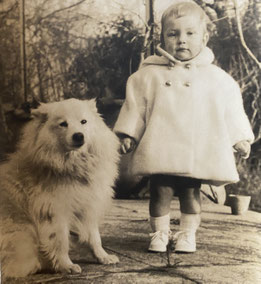
Another pro-argument for the German Spitz as a dog for families with children (especially toddlers or babies) is its lack of hunting drive. A falling child can trigger the prey drive in a dog with hunting drive in a fraction of a second - trained impulse control or not. If a dog attacks a child, this is not because of excessive aggression behavior, but rather simple prey-driven behavior. For example, the little boy Volkan Kaya was killed in year 2000 [6] and the 6-year-old boy Süleyman was killed in 2005 [7], both were killed from dogs by cooperative prey driven behavior, according to cynologist Dr. Dorit Feddersen-Petersen [8]. This cannot happen with the Spitz - due to his lack of hunting drive.
In this respect, the self-proclaimed "modernizers" of the German Spitz are completely wrong with their thesis that the Spitz needs to be adapted to today's times in order not to extinct ("Who wants sharp, highly reactive guard dogs today?"). The rough farm Spitz, with his stubbornness, sharpness and lack of hunting drive, couldn't be more suitable for families. He is not just one of those useless toy dogs who are happy when strangers chat up "his" children, but he comes into action - immediately. Guaranteed! And he doesn't pose any danger to "his" children!
7.) Conclusion
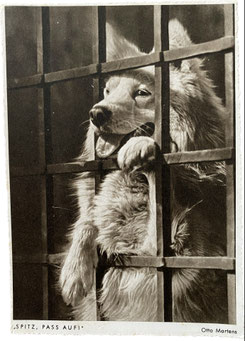
In my opinion, there are three reasons why people sometimes avoid talking about, for example, the German Spitz's sharpness: terms like "sharpness" sound too martial to some ears and are often used as a kind of negative trait. Or there is simply little or no knowledge about the basic elements of the Spitz's nature. Or, there is a fear of scaring off customers with such “negative” descriptions of this breed. Be that as it may, without those elements of its nature the Spitz would not be a proper German Spitz. And anyone who is put off by the sound of “sharpness” wasn’t right for the German Spitz breed anyway.
Therefore, you should not allow yourself to be led astray by the descriptions of the Spitz's character: it is precisely Spitz's apparently bad characteristics that shape him into an excellent and reliable guardian who protects his family with his life. The only important thing is that a dog like the Spitz, which may become dangerous, has to be particularly good at obedience and in training!
As has been mentioned so often on my website, the customer who would like to purchase the original German Spitz should look very carefully for the perfect breeder, as unfortunately there is now a tendency to no longer place any overriding value on the nature of the offspring in terms of breeding. A list of excellent German Spitz breeders who place a lot of emphasis on the original characteristics of the Spitz can be found on my site under “Spitz breeders”.
[1] Excerpt from FCI Standard No. 97/12.11.2019/D - German Spitz
[2] "Der Deutsche Spitz" no. 26, p. 3
[3] See. Dr. Rudolf Menzel: "Erbgut und Umwelt" ( Genetum and environment)
[4] Leonard Hoffmann: "Das Buch vom gesunden und kranken Hunde" (The book of healthy and sick dogs)
[5] See Ludwig von Merey: "Der Gebrauchshund: Seine Erziehung und Dressur" (The working dog: its training and dressage), p. 69 ff.
[6] https://de.wikipedia.org/wiki/Todesfall_Volkan_Kaya
[7] https://www.swissinfo.ch/ger/prozess-gegen-pitbull-halter-eroeffnet/5632458
[8] Vgl. Dr. Dorit Urd Feddersen-Petersen: "Ausdrucksverhalten beim Hund" (Expressive behavior in dogs), p. 319 f.
30.03.2023




